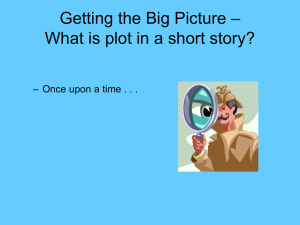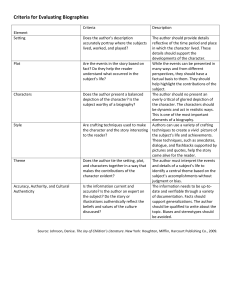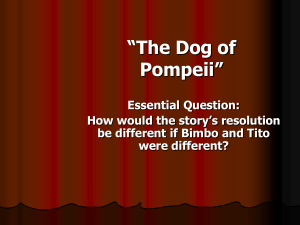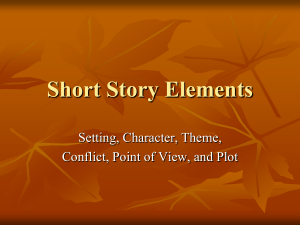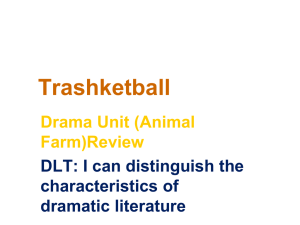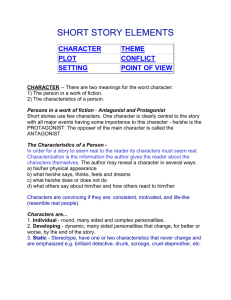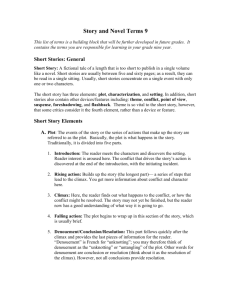Short Story Elements: Setting, Plot, Character & More
advertisement
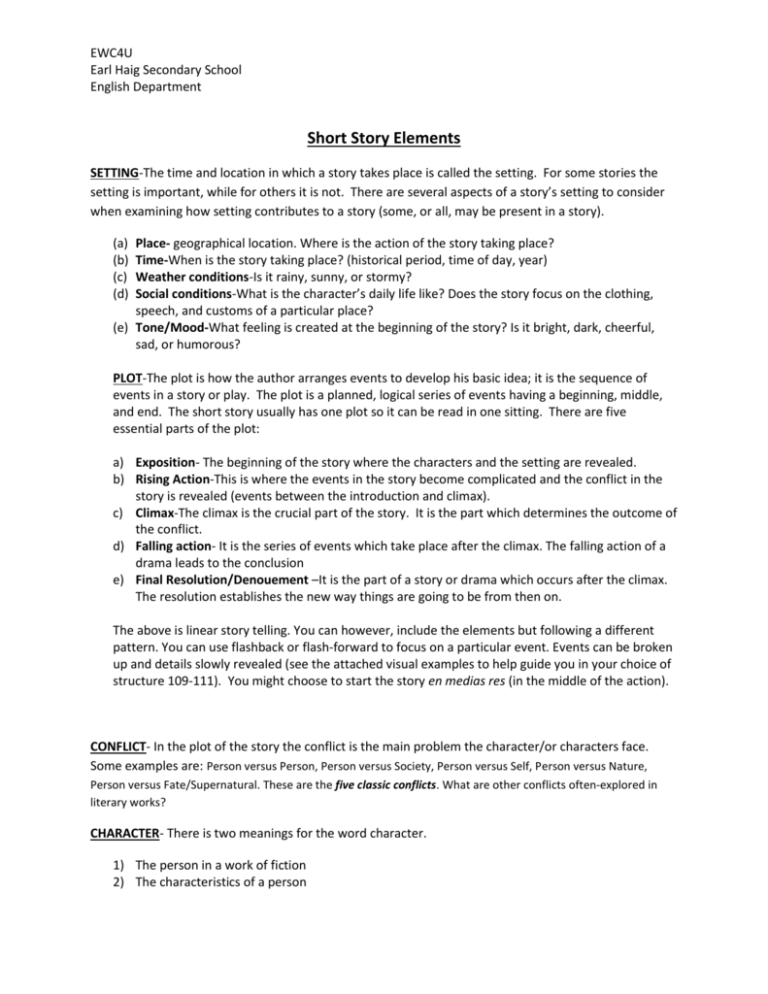
EWC4U Earl Haig Secondary School English Department Short Story Elements SETTING-The time and location in which a story takes place is called the setting. For some stories the setting is important, while for others it is not. There are several aspects of a story’s setting to consider when examining how setting contributes to a story (some, or all, may be present in a story). (a) (b) (c) (d) Place- geographical location. Where is the action of the story taking place? Time-When is the story taking place? (historical period, time of day, year) Weather conditions-Is it rainy, sunny, or stormy? Social conditions-What is the character’s daily life like? Does the story focus on the clothing, speech, and customs of a particular place? (e) Tone/Mood-What feeling is created at the beginning of the story? Is it bright, dark, cheerful, sad, or humorous? PLOT-The plot is how the author arranges events to develop his basic idea; it is the sequence of events in a story or play. The plot is a planned, logical series of events having a beginning, middle, and end. The short story usually has one plot so it can be read in one sitting. There are five essential parts of the plot: a) Exposition- The beginning of the story where the characters and the setting are revealed. b) Rising Action-This is where the events in the story become complicated and the conflict in the story is revealed (events between the introduction and climax). c) Climax-The climax is the crucial part of the story. It is the part which determines the outcome of the conflict. d) Falling action- It is the series of events which take place after the climax. The falling action of a drama leads to the conclusion e) Final Resolution/Denouement –It is the part of a story or drama which occurs after the climax. The resolution establishes the new way things are going to be from then on. The above is linear story telling. You can however, include the elements but following a different pattern. You can use flashback or flash-forward to focus on a particular event. Events can be broken up and details slowly revealed (see the attached visual examples to help guide you in your choice of structure 109-111). You might choose to start the story en medias res (in the middle of the action). CONFLICT- In the plot of the story the conflict is the main problem the character/or characters face. Some examples are: Person versus Person, Person versus Society, Person versus Self, Person versus Nature, Person versus Fate/Supernatural. These are the five classic conflicts. What are other conflicts often-explored in literary works? CHARACTER- There is two meanings for the word character. 1) The person in a work of fiction 2) The characteristics of a person EWC4U Earl Haig Secondary School English Department Persons in a work of fiction-Antagonist and Protagonist Short stories use few characters. One of the characters is clearly central to the story with all major events having some importance to this character-he/she is the PROTAGINIST. Often, the person that opposes the main character is called the ANTAGONIST. There are however, many possible sources of conflict. You may choose to write about external and internal conflicts that do not necessarily revolve around one antagonist. The Characteristics of a Person In order for the story to seem real to the reader its characters must seem real. Characterization is the information the author gives the reader about the characters themselves. The author may reveal a character in several ways: (a) (b) (c) (d) (e) (f) (g) (h) his/her physical appearance what he/she thinks, says, feels, and dreams what he/she does or does not do what others say about him/her and how others react to him/her their memories relationships to other characters manner of speaking attitudes, beliefs, and opinions Some aspects of the character (s) are communicated explicitly (directly stated), while other aspects are communicated indirectly (implicitly) through dialogue, other characters, or description. Characters are convincing if they are: consistent, motivated, and life-like (resemble real people). Make sure that if you do use dialogue it is clear, realistic, and voices are consistent. Characters are: 1. Developing/Dynamic-personality has many sides and changes, changes can be bad or good, by the end of the story. A developing or dynamic character can also be referred to as a round character. 2. Static-personality does not change, can be a stereotype, and may have one or two characteristics that are emphasized. Some examples include: the smart detective, mean stepmother, and scrooge. A static character is also often called a flat character. Consider Ernest Hemingway’s Iceberg Theory. You do not have to reveal everything about the character to the reader. In order to breathe life into a character however, you should have in depth knowledge of their appearance, background, values, beliefs, emotions, relationships, and reactions. You should be able to answer any questions about your character. EWC4U Earl Haig Secondary School English Department POINT OF VIEW Point of view is the angle from which the story is told. 1. Innocent Eye-the story is told through the eyes of a child. 2. Stream of Consciousness-The story is told so that the reader feels as if they are inside the head of one character and knows all their thoughts and reactions. The narrative however, must have some cohesion. When thoughts are too disparate readings are unable to follow. 3. First Person-the story is told by the main character or one of the characters close to the main character (using pronouns such as me, us, and I). 4. Third Person/Omniscient- the author can narrate the story using the omniscient point of view. The author can move from character to character, event to event, having free access to the thoughts, actions, and motivations of the characters. 5. Third Person/Limited-the author narrates the story, but the readers primarily see the events from the perspective of one character. 6. Second Person-The form is not as commonly used in narratives. The narrative form uses personal pronouns (I, me, and we) to tell the story. 7. Meta-fictional-The narrator is self-reflexive and acknowledges the elements of the narrative (the narrator has an awareness of audience and “breaks the fourth wall”). THEME The theme in a piece of fiction is its controlling idea. There can, however, be more than one theme in a piece of fiction. The theme may be an insight into the human condition or human nature. The theme can also serve to answer a question for readers or even pose one. Some examples of themes that you may have previously studied include: the search for personal identity, rites of passage (bildungsroman), and people’s inhumanity or propensity for evil. RHETORICAL DEVICES Rhetorical devices should be used with purpose: to emphasize an idea, conflict, theme, emphasize or draw attention to something important. . They also contribute to the story by creating vivid images in the mind of the reader. Some devices you can employ but are not limited to include: metaphor, simile, hyperbole, irony, personification (pathetic fallacy), symbolism and imagery. GENRE EWC4U Earl Haig Secondary School English Department Consider your choice of genre carefully. Each genre has its own conventions. The style of the composition is generally influenced by the genre you choose. Some genres to consider include: comedy, drama, horror tragedy, and science fiction. MOOD AND TONE In planning to write consider what feeling you hope to evoke (pathos) from your readers. What tone will you use to create such a mood? Will it be light-hearted, serious, or ironic?

